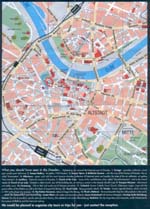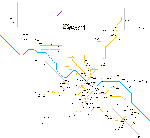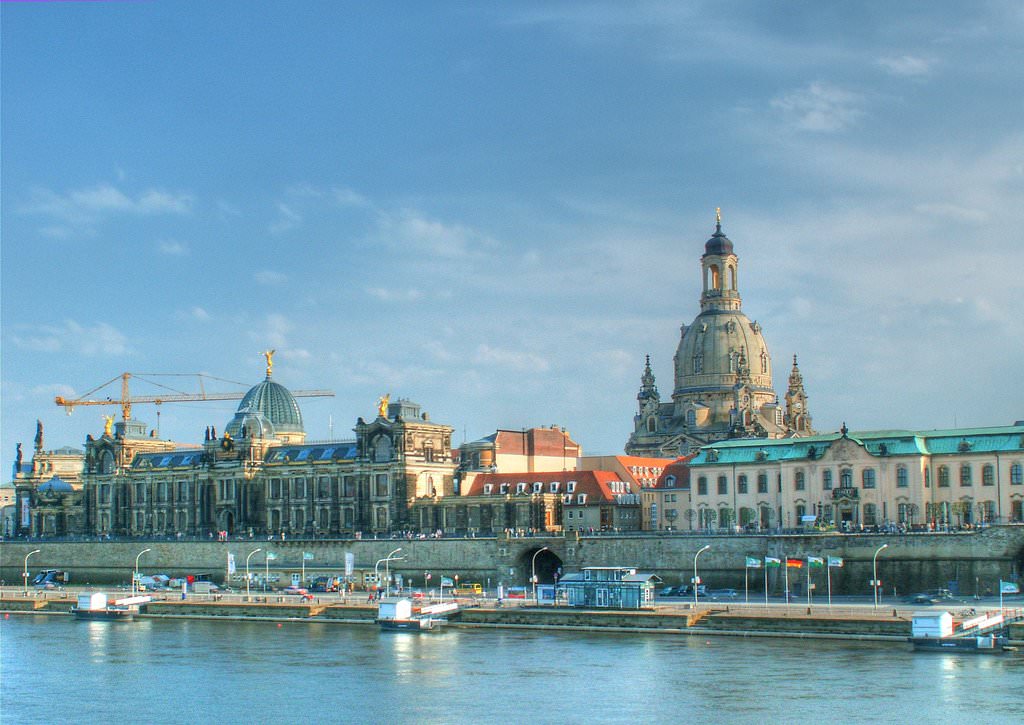Top architectural sightseeing and landmarks of Dresden - ideas on city exploration routes
Video of flights over top monuments of Dresden in HD format.
Use 'Full Screen' mode.
Frauenkirche, Dresden
Location on the map:  Facts:
Facts:
» The Frauenkirche, which is translated from German as the Church of the Virgin Mary, is one of the most significant Lutheran churches in Dresden. » The modern building was rebuilt at the site of an old sanctuary in 1995. When it was being reconstructed, 40% of old construction materials were used.
» The original 95-meter church was destroyed completely in the period of the Second World War when Dresden was bombed in 1945.
» The church is the third most visited attraction not only in Dresden, but also in all of Germany. The sanctuary is famous for its beauty, many tiny decorative items, moldings on the facade, and soft lines.
» The interior of the church is wonderful too. All the walls are painted in yellow and green. The altar and the organ at the church deserve special attention.
» Everyone can go up to the dome of the church and reach an observation platform that has a spectacular view of Dresden and its surroundings.
Japanese Palace, Dresden
Location on the map:  Facts:
Facts:
» The Japanese Palace is a unique construction located in the center of Dresden. Besides, the palace is the oldest museum in Germany that has survived to the present day. » The palace is an amazing combination of three architectural styles. The facade of the building is designed in the baroque and classical style. The roof is designed in the Chinese style.
» At one time, the castle was named the Dutch Palace. The palace has got its name due to its Chinese roof and relief paintings on the facade that depict Saxon and Asian people making porcelain.
» During the Second World War, the building was bombed and greatly damaged. It has been restored for 40 years.
» Nowadays, the palace is used as a museum. There is the Early History Museum and the Natural History Museum.
Bundeswehr Military History Museum, Dresden
Location on the map:  Facts:
Facts:
» The military history museum was built in 1877 and was used as Dresden’s garrison arsenal. In 1923, it became the Saxon Army Museum, and then the Army Museum in 1940. » After 1945, all military museums were closed. Most of the museum exhibits were taken to the Soviet Union as a reparation.
» An exhibition dedicated to the National People’s Army of the GDR and the Warsaw Pact armies was opened in 1957. A certain part of the museum property was brought back from the USSR.
» In 1990, the museum changed its name again and became the Bundeswehr Military History Museum. It contains all the information and over 10,000 exhibits showing the military history from 1300 to the present.
» In 2011, American architect Daniel Libeskind created a construction shaped like a wedge splitting the facade of the old building and symbolizing the turning points of the German military history. The museum building attracts and impresses tourists as much as its exhibitions.
» The first German submarine made in 1850 and the Soyuz-29 lander, in which Sigmund Jähn, the first German astronaut, landed, are displayed in the museum. Horror fans can visit an exhibition of ancient torture devices. It is interesting to visit a large exhibition dedicated to the time when Soviet troops were present in the GDR.
Dresden Rathaus, Dresden
Location on the map:  Facts:
Facts:
» The Dresden City Hall was built in 1910 and has been a symbol of Dresden since. » Its 100-metre tower can be seen from any part of the city. The tower is crowned with a five-metre sculpture of Heracles, the patron of Dresden. He holds the cornucopia in his hands. The sculptor’s model was the German weightlifter Ewald Redam.
» The tower has an observation platform with 16 stone sculptures symbolizing human virtues – Love and Hope, Wisdom and Goodness, Truth and Justice... The viewpoint has a wonderful view of the city landmarks and districts.
» According to an old German tradition, the building has a wine cellar. A sculptural composition called Bacchus on a Drunken Donkey stands before the entrance to the cellar. Bacchus’s big toe is shiny as it’s constantly being polished by visitors believing that it will bring them happiness and good fortune.
» Nearby there is a monument to German women who were sorting out the city ruins after the war. The restoration of the destroyed city hall building lasted until 1965. Nowadays it is a popular tourist attraction.
Garnisonskirche Sankt Martin, Dresden
Facts: » The Garrison Church of St. Martin is located on Stauffenbergallee in Dresden.
» The renowned garrison church is one of the most beautiful buildings in the city. The building stands out among other constructions in Saxon capital because of its non-baroque appearance. Architecturally, the religious building resembles Orthodox churches, except for the towers with sharp spires adjacent to the main building that are neo-Gothic in style.
» The main spire of the old garrison church tower is 91 metres high.
» The well-known religious shrine was built in the early 20th century, when German lands were inhabited by Slavic tribes.
» The Garrison Church of St. Martin survived the bombing of Dresden during the Second World War thanks to the fact that it was located quite far from the city centre.
» At the end of the 19th century, a military garrison stood on the site of the Garrison Church of St. Martin, but there was no church near it at that time. Therefore, it was decided to build a church where both Protestants and Catholics could eat, because soldiers of different faiths served in the garrison.
» Up to 1,300 people can gather in the church simultaneously.
» The Dresden landmark has excellent acoustics. The church has several choirs and its own orchestra. Their repertoire includes music by Bach, Brahms, Haydn, Mozart, Mendelssohn.
Holy Cross Church, Dresden
Facts: » Holy Cross Church got its name when Margrave Heinrich gave it the part of the Cross, on which, as the legend says, Christ was crucified.
» The first construction built at the site of the church in 1168 was a chapel.
» Since that time, the church was burned and destroyed many times but it was rebuilt completely in a different architectural style. The exterior of the building is the combination of Roman, Gothic, classical, Renaissance, and modern features.
» When it was last restored in 1955, the church was turned into a spacious and light building with a modest and even ascetic interior.
» The 92-meter tower and the belfry with 5 bells have survived to the present day in their pristine form. On the tower, there is an observation platform that has a panoramic view of the city.
» At the church, you can listen to the boys’ choir that has been existing for 700 years. 150 boys aged from 9 to 19 take part in it. The choir tours all over the world and sings classical and religious songs. Near the church, there is a monument to the 22nd choir director Julius Otto and his apprentices.
» In the church, 15-minute organ concerts are held twice a week. Here, you can listen to the biggest organ in Dresden.
Church of St. Ann, Dresden
Facts: » The Church of St. Ann is named after its benefactor, Princess Anna of Saxony.
» The modern church was built in 1769 at the site of an older one built in 1578 and destroyed by Prussian troops in 1760.
» The Church of St. Ann is one of the few churches in Dresden that have survived after two world wars.
» In 1824, a 57-meter neoclassical tower was added to the church and, as a result, the building has been recognizable.
» When it was bombed in February 1945, the roof was burned. However, it let about 1 000 people escape the bombing when they found refuge in the church. After the Second World War, no one engaged in the reconstruction of the church but it was restored after a while.
Kunsthalle im Lipsiusbau, Dresden
Facts: » Kunsthalle im Lipsiusbau was built in the 19th century.
» The building is named after its founder, Professor of Architecture Constantin Lipsius.
» Today, the building is open for all people who want to visit temporary exhibitions.
» As a rule, Kunsthalle im Lipsiusbau houses works of modern masters, as it is located near the Art Academy.
» The exhibition hall is open from 10 am to 6 pm every day except Monday.
This guide to architectural sightseeing in Dresden is protected by the copyright law. You can re-publish this content with mandatory attribution: direct and active hyperlink to www.orangesmile.com.
City tours, excursions and tickets in Dresden and surroundings
Build your walking routes in Dresden on the landmark map
Thailand Relaxes Its COVID-19 Policy
New Year events in Thailand are likely to bring more people this year because everyone is tired of lockdowns and craving normal life. Many tourists, who book hotels in Pattaya, Krabi, or Phuket for the holiday season, also want to participate. As champagne has become an essential drink for New Year celebrations, the question regarding alcohol consumption comes to mind. The government allowed serving alcoholic drinks during the New Year countdown but only open-air cafes and restaurants with good ventilation will be permitted to do this until 1 am on 1 January 2022. This rule is nationwide. Read this
Read this
26.04.2024
New Year events in Thailand are likely to bring more people this year because everyone is tired of lockdowns and craving normal life. Many tourists, who book hotels in Pattaya, Krabi, or Phuket for the holiday season, also want to participate. As champagne has become an essential drink for New Year celebrations, the question regarding alcohol consumption comes to mind. The government allowed serving alcoholic drinks during the New Year countdown but only open-air cafes and restaurants with good ventilation will be permitted to do this until 1 am on 1 January 2022. This rule is nationwide.
26.04.2024


 English
English Russian
Russian Dutch
Dutch German
German Spanish
Spanish French
French Türkçe
Türkçe


















